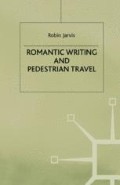Abstract
When the many pedestrian tourists introduced in Chapter 1 thought it proper in their written accounts to justify their mode of travel, their defence was invariably conducted in terms of the more complete freedom of movement permitted to the pedestrian. Adam Walker claims Rousseau’s support for the belief that ‘there is but one way of Travelling more pleasant than riding on horseback, and that is on foot; for then I can turn to the right and to the left’; Joseph Hucks gives the motives for his continuing preference as ‘convenience and independency’; and Mandet de Penhouet identifies the advantage of the foot-traveller over the carriage passenger as lying in a greater freedom to satisfy one’s curiosity along the way.1 William Bingley, writing at the end of the 1790s, spiritedly restates the case that is now becoming almost formulaic. Pedestrianism, he claims, is the most ‘useful’ mode of travel, ‘if health and strength are not wanting’:
To a naturalist, it is evidently so; since, by this means, he is enabled to examine the country as he goes along; and when he sees occasion, he can also strike out of the road, amongst the mountains or morasses, in a manner completely independent of all those obstacles that inevitably attend the bringing of carriages or horses.2
Access this chapter
Tax calculation will be finalised at checkout
Purchases are for personal use only
Preview
Unable to display preview. Download preview PDF.
Notes
John Thelwall, The Peripatetic; or, Sketches of the Heart, Of Nature and Society 3 vols. (London: published by the author, 1793) vol I, pp. 8–9.
Jean-Jacques Rousseau, Reveries of the Solitary Walker (1782; Harmondsworth: Penguin, 1979)p. 35.
Jeffrey Robinson, The Walk: Notes on a Romantic Image (Norman, OK and London: University of Oklahoma Press, 1989)p. 52.
Victor W. Turner, The Ritual Process: Structure and Anti-Structure (London: Routledge, 1969)pp. 94–5.
Robert Southey, Letters from England, ed. Jack Simmons (London: Cres-set Press, 1951)pp. 415–27.
John Urry, The Tourist Gaze: Leisure and Travel in Contemporary Societies (London; Sage, 1990)p. 10.
Erik Cohen, ‘A Phenomenology of Tourist Experiences’, Sociology, XIII (1979) 182.
Christopher Hussey, The Picturesque: Studies in a Point of View (London: G.P. Putnam, 1927; rpt. London: Frank Cass, 1967)pp. 130–1.
See William Gilpin, Observations on the River Wye (London: R. Blamire, 1782)p. 7.
See William Gilpin, Three Essays: On Picturesque Beauty; on Picturesque Travel; and on Sketching Landscape (London: R. Blamire, 1792)pp. 16–18.
Richard Payne Knight, The Landscape; a Didactic Poem (London: W. Bulmer, 1794) I.317–28.
Author information
Authors and Affiliations
Copyright information
© 1997 Robin Jarvis
About this chapter
Cite this chapter
Jarvis, R. (1997). An Anatomy of the Pedestrian Traveller. In: Romantic Writing and Pedestrian Travel. Palgrave Macmillan, London. https://doi.org/10.1057/9780230371361_2
Download citation
DOI: https://doi.org/10.1057/9780230371361_2
Publisher Name: Palgrave Macmillan, London
Print ISBN: 978-0-333-79460-9
Online ISBN: 978-0-230-37136-1
eBook Packages: Palgrave Literature & Performing Arts CollectionLiterature, Cultural and Media Studies (R0)

